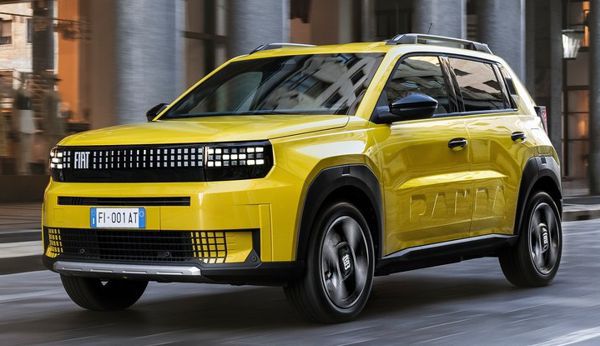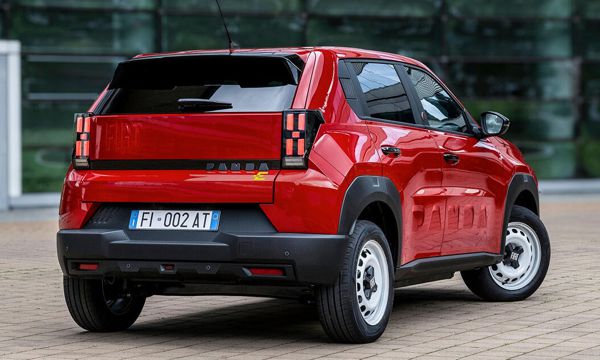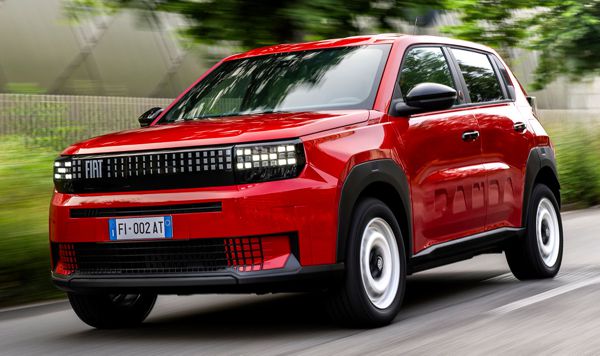Published
on 11
Feb 2025
|
All rights reserved.
|
|

|
|
Smart
design and packaging lead Fiat back to the forefront of supermini
field...
|
|
As suggested by its name,
the new Fiat Grande Panda is not exactly a replacement to the
13-year-old Panda. That car will soldier on to at least 2027 as Fiat
struggles to develop another small car so cheap. The Grande Panda is a
larger car, measuring 4 meters long instead of 3.7 meters, about 100mm
wider and slightly taller as well. Size-wise, it takes the space left
by Punto since 2018, but its design philosophy is closer to the
original Panda. That’s why it is called Grande Panda. It is built on
the low-cost Smart Car Platform of Stellantis thus is the sister car of
Citroen
C3. In fact, the familiar size and shape suggest that it is
mechanically identical to the Citroen, thus what differing them are
mostly the packaging.
Speaking of packaging, the Fiat is certainly more stylish – and even
innovative – than the dull Citroen, thanks in part to its funky
dot-matrix headlights / pseudo-grille and taillights. Its body is
squarer and edgier, has strong SUV pretension, although the small Fiat
is purely front-wheel drive. It catches eyes by using vibrant paint
colors such as yellow, red, azure and bronze to deliver a youthful and
cheerful flavor. Fiat’s designers did an amazing job to distinguish it
from the mainstream by featuring many funky identity elements. For
example, the door panels and tailgate are stamped with large "PANDA"
and "FIAT" wording, respectively, which is quite innovative without
adding costs. The plastic portions of C-pillars and wheel arches have
the old Fiat 4-bar logos molded. In addition to the 3D Panda wording at
the tailgate, I have never seen a car has so many identifiers!

|
|
"PANDA"
stamped on the sides, "FIAT" at the tailgate, and many other badges all
over the car.
|
|
Inside, it looks equally creative and cheerful. It is bright and
colorful, with some yellow inserts and good-looking bamboo-based fabric
trims on the dashboard in top spec. model. The oval dashboard and
instrument / touch screen surrounds are inspired by the legendary
roof-top test track on Fiat's Lingotto factory. Plastics are hard, of
course, to keep costs low, but it doesn’t feel cheap thanks to the
great design. There is a simple instrument display and a 10.25-inch
touchscreen which provides pretty basic functions. At least the user
interface is easy to use. There are lots of storage space in the
cabin, while the 361 liters boot is remarkable for the class. The rear
bench has just enough space to accommodate a 5ft 11in folk behind a
driver of the same size without much pain, which is not always the case
for superminis. Rear headroom is aided by the tall roof, although foot
room is tight under the front seat cushions as the cabin floor is
elevated.
The floor is so high because the Grande Panda is designed to
accommodate mild-hybrid ICE or pure battery power, just like Citroen C3
and e-C3. The former uses Stellantis' turbocharged 1.2-liter triple and
6-speed DCT gearbox in which a 48V / 29hp electric motor incorporated
(see Fiat 600 Hybrid for more
details). It offers just 100hp and good
for 0-60 mph in 9.4 seconds. The petrol car starts at a very reasonable
£19,000.

|
|
Oval
shape dash inspired by legendary Lingotto plant.
|
|
However, the electric version is even more appealing. It starts at
£21,000 and rising to £24,000 for top spec. trim, which
undercuts even its Citroen sibling to be the cheapest proper 4-seat EV
you can buy in Europe – considering Dacia Spring is not that proper. It
is considerably cheaper than Renault 5, too, although it is also less
sophisticated than the French star. It uses a 44 kWh LFP battery from
Chinese supplier SVOLT to deliver 199 miles range (WLTP), or about 150
miles in the real world. The Fiat’s boxy shape does not help energy
efficiency, but that’s okay for a car designed for primarily urban
commute. Ditto the small front-mounted motor which generates 113
horsepower and only 88 pound-foot of torque, demanding over 10 seconds
to
sprint from rest to 60 mph. There is certainly no typical EV-sensation
of step-off acceleration to speak of, but again for an urban
small car associated with the Panda name it is easily forgivable –
remember the 1980 Panda took 18
seconds to do so?
As for charging, 100kW DC quick charge is about the norm of the class,
which takes half an hour to charge from 20-80 percent. Besides, the
Fiat provides a retractable 7kW AC charge cable, which can be pulled
out from the pseudo-grille, so that you don’t need to put charging
cables in the boot. Nice touch.

|
|
Like
the original Panda, it is all about remarkable packaging and value for
money...
|
|
On the road, the Grande Panda electric does most jobs well but without
the added refinement or excitement of the best superminis. Although
skipping Citroen C3’s hydraulic bump stops, its suspension soaks up
bumps and potholes really well, delivering remarkable composure in
urban environment. Body roll is more pronounced than, say, a Renault 5,
but nothing hurting. Its handling is tidy and predictable if a little
unexciting. The steering is direct and well weighted but delivers
little road feel. On faster roads, the ride gets busier and the cabin
gets noisier, lacking the refinement of Renault, but that is already
expected for a car built on the low-cost Smart Car platform. With
limited power you also need to have better planning before overtaking
from the fast lane.
In the end, the Grande Panda is not about driving dynamics or
refinement. Like the original Panda, it is all about remarkable
packaging and value for money. You get a tasteful design inside and
outside, space efficient packaging, many practical features and a
robust feel, all at a bargain price. It is not as rounded as Renault 5,
but being used as an urban car it has very strong appeal to the car
buying public, certainly stronger than Citroen C3, Dacia Spring and
Hyundai Inster. Is it as good as conventional superminis like Clio,
Ibiza or 208? Probably not, but the little Fiat proves that EVs could
be competitive against ICE rivals in supermini class even without
incentives. Take its lower running costs into account, it is
unquestionable that cost parity between ICEs and EVs has finally
arrived the supermini class, just as Renault boss Luca de Meo declares
last year.
|
Verdict:     |
|